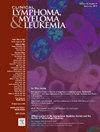Real-World Treatment Patterns and Clinical Outcomes in Patients With Multiple Myeloma Previously Treated With Lenalidomide and an Anti-CD38 Monoclonal Antibody
IF 2.7
4区 医学
Q2 HEMATOLOGY
引用次数: 0
Abstract
Background
This analysis explored real-world characteristics, treatment patterns and clinical outcomes in patients with relapsed or refractory multiple myeloma (RRMM) previously treated with lenalidomide and an anti-CD38 monoclonal antibody (mAb) and requiring subsequent treatment.
Materials and Methods
The PREAMBLE and Connect MM prospective registries of patients with multiple myeloma (MM), and the US nationwide Flatiron Health electronic health record-derived de-identified database were analysed. MM-specific treatment patterns (prior/index therapies) and outcomes (progression-free survival [PFS]/overall survival [OS]) were assessed.
Results
This analysis included: PREAMBLE n = 215; Connect MM n = 232; Flatiron Health n = 845. Median age at index was 69.0 years, median 3 prior lines of therapy; > 50% male. The most common index regimens accounted < 15% of treatments (most common PREAMBLE, Connect MM: carfilzomib±dexamethasone; Flatiron Health: pomalidomide+daratumumab+dexamethasone); most patients received classes that they had previously; ≥ 93% were triple-class exposed (immunomodulatory drug, proteasome inhibitor, anti-CD38 mAb). In PREAMBLE, Connect MM and Flatiron Health, respectively: 80.9%, 68.1% and 77.2% were lenalidomide- and anti-CD38 mAb-refractory; 69.3%, 67.2% and 71.1% were triple-class refractory (TCR); median PFS: 5.2 (95% CI 3.7-6.7), 4.4 (3.5-5.6) and 5.3 months (4.8-6.0); median OS: 19.3 (15.8-26.1), 14.2 (11.0-16.9) and 23.1 months (19.0-28.6). PFS and OS were shorter in lenalidomide- and anti-CD38 mAb-refractory patients versus those who were not refractory to both. A similar pattern was observed for TCR patients versus non-TCR patients.
Conclusion
There is no uniform standard of care for patients with RRMM with prior exposure to lenalidomide and anti-CD38 mAbs. Survival outcomes are poor, with a need for effective treatments for these patients.
来那度胺和抗cd38单克隆抗体治疗的多发性骨髓瘤患者的真实世界治疗模式和临床结果
背景:该分析探讨了复发或难治性多发性骨髓瘤(RRMM)患者的现实世界特征、治疗模式和临床结果,这些患者先前接受过来那度胺和抗cd38单克隆抗体(mAb)治疗并需要后续治疗。材料和方法:对PREAMBLE和Connect MM多发性骨髓瘤(MM)患者的前瞻性登记,以及美国全国Flatiron Health电子健康记录衍生的去识别数据库进行分析。评估mm特异性治疗模式(既往/指数治疗)和结果(无进展生存期[PFS]/总生存期[OS])。结果:本分析包括:前言n = 215;连接MM n = 232;熨斗健康n = 845。指数时中位年龄为69.0岁,既往治疗中位为3线;> 50%男性。最常见的指标方案占治疗的< 15%(最常见的前言,连接MM:卡非佐米±地塞米松;Flatiron Health:泊马度胺+达拉单抗+地塞米松);大多数病人接受了他们以前上过的课程;≥93%为三级暴露(免疫调节药物、蛋白酶体抑制剂、抗cd38单抗)。在PREAMBLE中,Connect MM和Flatiron Health分别为:80.9%,68.1%和77.2%是来那度胺和抗cd38单抗难治;69.3%、67.2%和71.1%为三级难治(TCR);中位PFS: 5.2 (95% CI 3.7-6.7)、4.4(3.5-5.6)和5.3个月(4.8-6.0);中位OS: 19.3个月(15.8-26.1),14.2个月(11.0-16.9)和23.1个月(19.0-28.6)。来那度胺和抗cd38单克隆抗体难治性患者的PFS和OS比两者都不难治性患者短。在TCR患者和非TCR患者中观察到类似的模式。结论:对于先前暴露于来那度胺和抗cd38单抗的RRMM患者,没有统一的护理标准。生存结果很差,需要对这些患者进行有效的治疗。
本文章由计算机程序翻译,如有差异,请以英文原文为准。
求助全文
约1分钟内获得全文
求助全文
来源期刊

Clinical Lymphoma, Myeloma & Leukemia
ONCOLOGY-HEMATOLOGY
CiteScore
2.70
自引率
3.70%
发文量
1606
审稿时长
26 days
期刊介绍:
Clinical Lymphoma, Myeloma & Leukemia is a peer-reviewed monthly journal that publishes original articles describing various aspects of clinical and translational research of lymphoma, myeloma and leukemia. Clinical Lymphoma, Myeloma & Leukemia is devoted to articles on detection, diagnosis, prevention, and treatment of lymphoma, myeloma, leukemia and related disorders including macroglobulinemia, amyloidosis, and plasma-cell dyscrasias. The main emphasis is on recent scientific developments in all areas related to lymphoma, myeloma and leukemia. Specific areas of interest include clinical research and mechanistic approaches; drug sensitivity and resistance; gene and antisense therapy; pathology, markers, and prognostic indicators; chemoprevention strategies; multimodality therapy; and integration of various approaches.
 求助内容:
求助内容: 应助结果提醒方式:
应助结果提醒方式:


